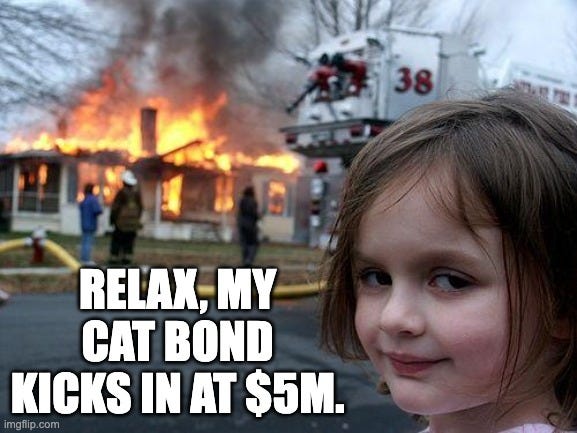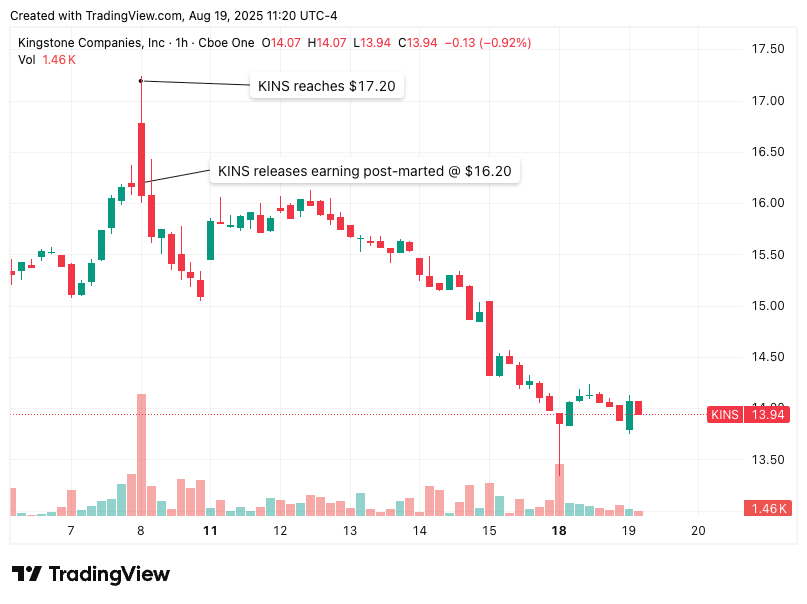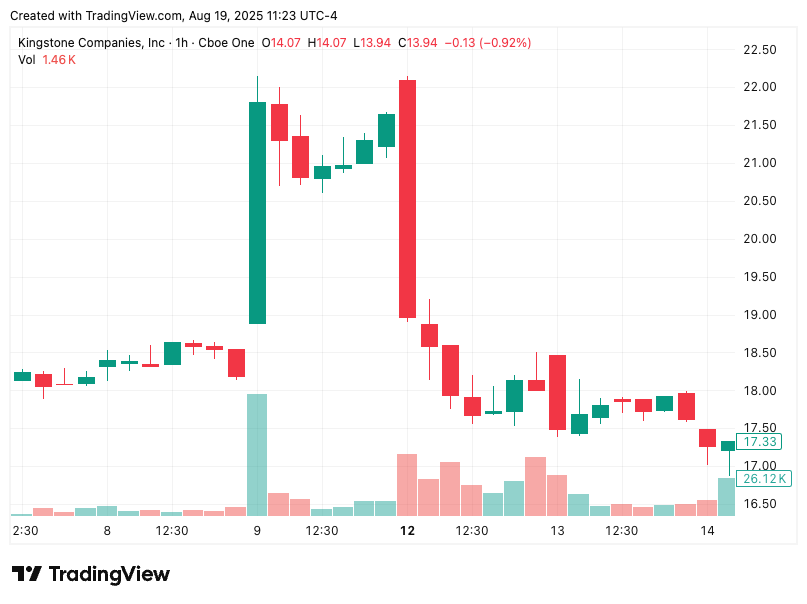KINS Q2: Profits, protection, and a bigger plan
Record EPS, stronger reinsurance, higher guide: I’m still holding
I tend not to send standalone commentary on company earnings. For KINS, I think it’s warranted. Results were strong, and the stock even popped after hours. But it then drifted down on no news flow to just under $14 per share as of today.
The same thing happened after Q1 earnings. The stock jumped from $18.50 to $22, then fell back to the $18s in a couple of days.
This is common for a company this small (<$200 million market cap).
Q2 was clean. Profitable underwriting, record earnings, sturdier reinsurance, and clearer long-term goals. This is what I wanted to see.
If you want a refresher on my original thesis before diving in, read this:
I’m still holding the shares in the portfolio. I’m not adding. As I’ve mentioned before, the risk/reward for KINS is more balanced than asymmetric, so it’s a candidate for replacement if I find a better opportunity.
The quarter at a glance (my quick read)
Record profitability. Annualized ROE was 50.8%. The net combined ratio came in at 71.5%. Net income hit $11.3M and diluted EPS was $0.78, the highest quarterly EPS since 2010.
Top-line and earned growth. Net premiums earned rose to $46.2M (+52% y/y).
Core growth, non-core shrink. Core direct written premium grew ~17%; non-core continued to wind down by design.
Reinsurance reset. Management increased the catastrophe limit by 57% with a <10% price increase and issued the first $125M cat bond; first-event retention stays $5M.
Guidance raised. 2025 guide now assumes NPE = $187M, combined ratio 79%–83% (from 81%-85%), basic EPS $2.10–$2.50 (from $1.90-$2.30), diluted $1.95–$2.35 (from $1.75-$2.15), ROE 30%–38% (from 27% - 35%).
Capital signals. Dividend reinstated; new CFO named; board refreshed.
None of this is a victory lap. It’s a checkpoint. Below is how I’m thinking about the drivers, the call, and how it all lines up with my thesis.
What drove the print
Underwriting did the heavy lifting. The 71.5% combined ratio reflected low cats (0.6 pts) and a touch of favourable prior-year development (0.5 pts). Management also called out an ongoing drop in non-weather water frequency (homeowners’ biggest everyday peril) as the mix shifts toward Select risks.
Earned premium tailwind. Net premiums earned jumped 52% to $46.2M as the company retained more via a lower quota share and continued to earn in the surge of new business written in H2’24.
Investments helped. Net investment income rose to $2.3M (+30% y/y). The company put $17.7M to work in MBS/ABS at a 5.6% book yield with 4.5-year duration. Lower rates also added $1M in unrealized gains this quarter.
Expenses are stable. The expense ratio ticked up in the quarter to 32.7% (ceding-commission mechanics), but management expects the full-year ratio to land in line with 2024 as commissions reset higher with better loss ratios. Year-to-date sits at 32%.
Capital base looks healthier. Stockholders’ equity stood at ~$94.9M at quarter-end.
Reinsurance: more cover, smarter cost
I care more about downside protection than one more point of growth. The new cat program checks the right boxes:
+57% higher limit, <10% price increase.
$125M of multiyear protection via the first cat bond.
$5M first-event retention; management illustrated a Sandy-like scenario where reinsurers cover ~$90M out of $95M.
On the call, management also clarified second-event retention at $9M (about $7M after tax). That matters for tail scenarios.
Guidance and the new 5-year goal
Management raised 2025 profitability metrics while grounding them in NPE = $187M, CR 79%–83%, and diluted EPS $1.95–$2.35 with ROE 30%–38%.
They also set a five-year goal to reach $500M written premium, doubling the business through organic growth in New York and measured expansion to two new states in 2026 and two more in 2027. The tone was: grow where we know, test and validate in new geographies, avoid old mistakes.
What I heard on the earnings call (notes + Q&A)
Management framed Q2 as the most profitable quarter in company history, and paired it with dividend reinstatement, a new CFO (Randy Patten), and a refreshed board.
Operating highlights (from remarks).
Frequency improvements in homeowners continue; the Select mix is the driver. All-perils (ex-cat) frequency down ~29% y/y in the quarter. Cat losses contributed only 0.6 pts to the loss ratio; reserves added 0.5 pts of favorability.
Expense ratio: 32.7% in Q2, 32% YTD; expected to mirror 2024 for the full year.
Reinsurance: higher limit, first cat bond, cost per dollar of earned premium down ~5% vs the prior treaty period.
Guidance and strategy (from remarks).
Raised 2025 profitability metrics and codified the $500M premium 5-year target; Investor Day to follow.
Analyst Q&A (my curated bits).
Reinsurance structure / second event. Janney asked about the cat program and retentions. Management said second-event retention is $9M (about $7M after tax).
Expense ratio and expansion. Question on expansion impact. Management expects minimal impact; they plan measured expansion and keep the expense ratio in line.
AmGuard renewal rights transaction. The near-term premium estimate is $12M for the first 12 months; the benefit will be spread more proportionately over three years rather than front-loaded.
Capital allocation/buybacks. Asked about buybacks, management said no plans now; they may need capital to execute the plan and will consider alternatives as needed.
How did this hit my original thesis?
My base case in the deep dive was simple: a refocused New York book, the “Select” homeowners product, tighter underwriting, reinsurance priced into the product, and a sustained lower expense base could deliver durable sub-85% combined ratios and double-digit ROE, with upside from measured growth. I viewed the stock as a Hold after a big run, but with 20%–30% more upside if execution held.
Here’s how Q2 lines up against that:
Refocus on core/pruning non-core. The company has kept shrinking non-core and growing the downstate New York core. Q2 maintained that pattern. That’s straight out of the thesis.
Select product is doing its job. Frequency on the key non-weather water peril keeps falling as Select takes mix. Management tied the frequency drop to Select’s risk selection and underwriting. This is exactly the product-mix edge I wanted to see persist.
Expense discipline. Even with commission timing noise, the full-year target is to keep the ratio in line with 2024. That supports the “durable lower expense base” leg of the thesis.
Reinsurance is aligned with risk. More limit, a cat bond, and a steady $5M first retention align with the “price for cat and buy more air cover” playbook i flagged. The second-event colour adds comfort.
Profitability cadence. A 71.5% combined ratio sits well ahead of my “sub-85% is sustainable” view and supports the raised full-year guide.
Net, Q2 strengthens the core of the thesis. It also nudges the growth line item from “optional” to “more probable,” given the five-year plan and market setup in NY.
Risks and what I’m watching
Weather and reinsurance. The cat tower is stronger and cheaper per dollar of earned premium, but second-event exposure still exists. I’ll watch severity in late-year quarters and any 2026 shift if the personal lines quota share isn’t renewed.
Execution on expansion. Management aims to enter two states in 2026, two in 2027. The right way is crawl-walk-run with strict rate adequacy. They said exactly that; now they need to do it.
Capital allocation. Dividend is back, but no buybacks for now due to growth plans and optionality around capital. If the stock dislocates and capital is ample, I’ll revisit this.
AmGuard run-rate. The transaction is still helpful, but the premium timing is now smoother over three years, not front-loaded. That affects near-term optics.
Industry backdrop. Management described the homeowners market as strained, which is good for pricing but still a risk if regulators push back. Keep an eye on filings and competitor behaviour in New York.
Bottom line
Q2 shows a business that can produce underwriting profit and grow without loosening standards. The Select mix keeps lowering frequency. The reinsurance stack carries more cover at a better effective cost. Guidance moved up, and the five-year target gives a clearer lane for scale. None of this removes tail risk; it does tighten the guardrails.
For my thesis, this quarter is an affirmation. I said the easy gains were in, and the setup still pointed to 20%–30% upside with steady execution; that still fits, and visibility improved. I’ll keep tracking expense discipline, quota share decisions into 2026, and the first steps into new states. If the company keeps posting sub-85% combined ratios and compounds book value with a sturdier cat program, the equity case remains intact.








